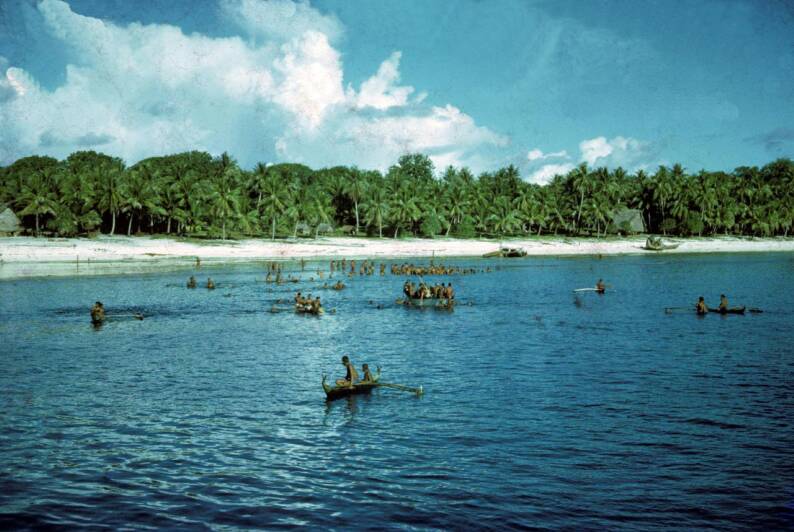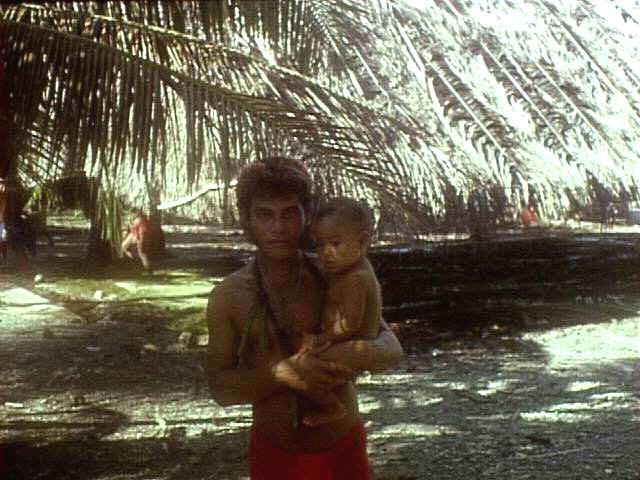A Return to Paradise
In August 1967, Gary and I headed off for Micronesia and a three-year adventure in the newly formed US Peace Corps. It was the height of the Vietnam War. We were newly married and graduated and anxious to “make peace.”
We really didn’t know anything about Micronesia, except that it was an American trust territory monitored by the United Nations, and considered a bunch of islands stretching 3,000 miles across the Pacific Ocean. If one compressed the land mass, it would fill up one-half of Rhode Island.
We started our Peace Corps experience by training for three months on an island in the Truk (now Chuuk) Lagoon. We then moved to Yap Island, the administrative center for Yap District and home of stone money. We lived in the jungle in a tiny house—6 feet by 20 feet—with two doors and two windows. I taught school and Gary worked out of the agricultural station. After eight months, Gary took a field trip ship to all of the Outer Islands (a chain of small islands stretching over 500 miles of ocean). The trip took two weeks.
When Gary returned, he raved about Satawal. It was an island, one by one-half miles, with a population of 400 people. But, to Gary, it looked like paradise! They needed a teacher and agricultural help, and they desperately wanted to host the Peace Corps. So off we went, learned a new language, and read the sky.
It was like moving into the pages of the National Geographic Magazine. Men wearing loincloths sailed the open ocean in hand-made canoes, which they navigated using the directions passed down orally from father to son. It was based on stars, currents, and intuition. The women tended the taro patch and wove skirts from fiber made from barren trees. Everyone lived outdoors and had small thatched sleeping houses.
I and two other teachers taught 100 children, ages six to fourteen. The head teacher had three years of schooling under the Japanese, so we did lots of teacher training, too.
Everything on Satawal was done communally—everyone helped everyone. Tuesday and Thursday were island work days, when projects that benefited everyone were done: for example, replanting the coconut groves and building new canoes, houses, or a huge covered water catchment. I learned how to teach, not through competition that separated people from each other, but through group action and concerns. The students helped each other, and they all learned quickly.
We were warmly welcomed on Satawal, given a house and provided with food every day. It was a joyous time. I helped deliver 30 babies (three were named Pam), learned to dance and weave, and how to cook on an open fire. This was a learning experience for us, too.
Since those days, we have dreamed of visiting “our island.” We learned so much about community, caring, love, and respect there. But it takes three to four months to visit. The field trip schedule has not improved in 30 years. Every two to three months, one ship makes it to Satawal, stays only a few hours because there is no anchorage, and steams off—not to return until the next trip.
Then, in April of 2002, we got an e-mail from one of my former students, now Lieutenant Governor of the island chain. He invited us to a “huge celebration.” Another one of my students had been studying for the Catholic priesthood and was to be ordained on his home island. Since this was a special occasion, the Government had arranged a special schedule of the field-trip ship to take visitors from Chuuk out to Satawal (a two-day trip) and return two days later to pick them up again. If we could get to Chuuk Lagoon by June 12, we could catch the ship for the quick trip to Satawal. Even though leaving the farm in June would be especially difficult, the temptation to see our old friends again was too much to resist. Luckily, the crew here was ready to hold down the fort for the two weeks we would have to be away.
Daughter Tannwen decided to join us. Having grown up with all our stories, it would be a treat for her to see Satawal for herself.
So on June 10, off we went, flying to Houston, Hawaii, Guam, then overnight in Chuuk, and on the boat for the two-day trip to Satawal (a total of five days of traveling just to get there!). What an adventure we had! A journey of 13,000 miles each way and 35 years back in time!
The reunion began on deck—many former students and friends were heading back to celebrate the first Satawalese son to become a priest. Tannwen and I had changed into traditional hand-woven skirts, and we all stood on the ship’s deck to watch as Satawal Island grew larger on the horizon. What would it be like? Would we remember any language?
Between ocean swells, we jumped from the ship onto a small motorized launch and headed for the beach. We were totally overwhelmed by our welcome. More than 200 women and girls, dressed in beautiful woven skirts decorated with flower leis and painted with red lipstick and orange tumeric, were lined up on the beach dancing and singing a welcome song for “Pam ma Gary.” Our three days on Satawal were truly wonderful.
The chiefs seated us next to them and asked for our counsel. We were invited to sleep in a simple house with the family we had lived with 35 years ago. There were hugs and tears and welcomes at every turn.
Much had changed in the school where I had taught. Now, over 150 students occupied two new school buildings. The four cartons of children’s books that we had brought for the school were warmly received.
Satawal was now home to 600 people, and there were children everywhere! As we remembered, the island population was focused on its children—and they were showered with love. On Satawal Island, all children have a biological family and an adoptive family (both large and extended) to watch over them.
The weekend was filled with feasts and dancing. The women, serious and well-practiced, put on wonderful dance performances. The men lined up for fun, but had obviously not rehearsed—just a lot of hip-shaking and laughter.
The ordination service was in the newly renovated church; the old one was washed away in a typhoon two years ago. Everyone wore traditional clothes and lots of flowers. After the church service, the eldest navigator (the most esteemed role on the island, since all the men are seafaring) performed an ancient ritual usually done for a man who has proven himself to be a master navigator. The ceremony was adapted to celebrate the ordination—a navigator of a different sort.
It was rewarding for us to learn that the people of Satawal have, over the years, “figured it out.” They have accepted the positive aspects of Western culture, while treasuring and protecting their own culture and traditions. Their sense of unified community, working together, protecting the children, and revering the old ways of sailing and boat-building are consciously emphasized.
Many of my students have gone off-island. Some returned with college degrees—pediatric doctor, teachers, principals, nurses, government officials, transportation manager. Many have traveled throughout the Pacific and the United States. But all return to Satawal to raise their children and celebrate one another.
Gary’s projects—replanting coconut groves with large, productive coconuts and building a huge cement water catchment to provide clean drinking water—are points of great pride on the island.
Tannwen was folded right into the community—everyone agreed her name was from Satawal and meant “Dream Come True.” (Actually, it’s of Welsh origin.)
All too quickly the three-day visit was over, and we had to catch the boat back to Chuuk. We hated to leave, but were so glad we had the opportunity to revisit a very important time in our lives.
Pam Mount
Terhune Orchards
Princeton, NJ
April 2006
(Originally published in two parts on the Terhune Orchards website, spring 2002, and in the Terhune Orchards News, fall 2002.)

Click here to add text.
Photograph by Mike Lemont
Photograph by Mike McDevitt

